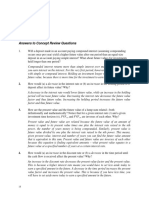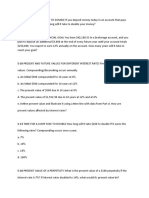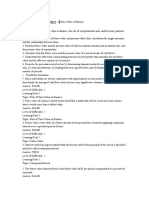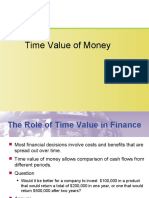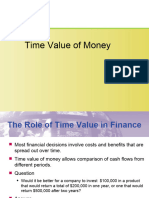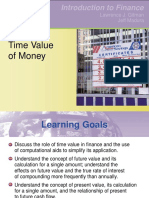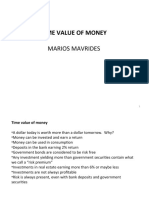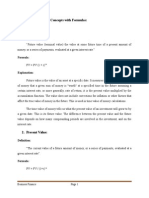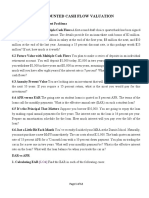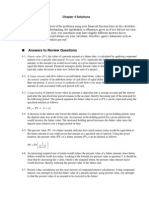0% found this document useful (0 votes)
94 views6 pagesTime Money Problem
Chapter 5 covers the Time Value of Money (TVM) concepts, including future and present value calculations, loan amortization, and effective interest rates. It provides self-test questions and problems to reinforce understanding of how interest rates affect savings and investments over time. The chapter also discusses various compounding periods and their impact on future and present values.
Uploaded by
ae.iridp3.b.bariaCopyright
© © All Rights Reserved
We take content rights seriously. If you suspect this is your content, claim it here.
Available Formats
Download as PDF or read online on Scribd
0% found this document useful (0 votes)
94 views6 pagesTime Money Problem
Chapter 5 covers the Time Value of Money (TVM) concepts, including future and present value calculations, loan amortization, and effective interest rates. It provides self-test questions and problems to reinforce understanding of how interest rates affect savings and investments over time. The chapter also discusses various compounding periods and their impact on future and present values.
Uploaded by
ae.iridp3.b.bariaCopyright
© © All Rights Reserved
We take content rights seriously. If you suspect this is your content, claim it here.
Available Formats
Download as PDF or read online on Scribd
/ 6
Chapter 5 Time Value of Money 183
Self-Test Questions and Problems
ra pres tee nests ms
caret
BI FOE REN FeMgPCFvAg
eee
a
aera
a ae ee eee ere
(hare panera cah nope aca 9
ee remem
ee ee
ST-2 FUTURE VALUE It is now January 1, 2018. Today you will deposit $1,000 into a savings
account that pays 8%.
4. Ifthe bank compounds interest annually, how much will you have in your account on
January 1, 2021?
. What will your January 1, 2021, balance be ifthe bank uses quarterly compounding?
©. Suppose you deposit $1,000 in three payments of $333.333 each on January 1 of 2019,
2020, and 2021. How much will you have in your account on January 1, 2021, based on.
{8% annual compounding?
4. How much will be in your account ifthe three payments begin on January 1, 2018?
«©. Suppose you deposit three equal payments into your account on January 1 of 2019,
2020, and 2021. Assuming an 8% interest rate, how large must your payments be to
hhave the same ending balance as in part a?
ST-3 TIMEVALUE OF MONEY It is now January 1, 2018, and you will need $1,000 on January 1,
2022, in 4 years. Your bank compounds interest at an 8% annual rate
a. How much must you deposit today to have a balance of $1,000 on January 1, 2022?
b. Ifyou want to make four equal payments on each January 1 from 2019 through 2022
‘to accumulate the $1,000, how lange must each payment be? (Note that the payments
begin a year from today)
IF your father offers to make the payments calculated in part b ($221.92) orto give you
{$750 on January 1, 2019 (a year from today), which would you choose? Explain.
4. IF you have only $750 on January 1, 2019, what interest rate, compounded annually for
3 Years, must you earn to have $1,000 on January 1, 2022?
{. Suppose you can deposit only $200 each January 1 from 2019 through 2022 (4 years).
‘What interest rate, with annual compounding, must you earn to end up with $1,000 on
January 1, 20227
£ Your father offers to give you $400 on January 1, 2019. You will then make six addi-
tional equal payments each 6 montis from July 2019 through January 2022. If your
bank pays 8% compounded semiannually, how large must each payment be for you
to end up with $1,000 on January 1, 2022?
‘g What is the EAR, or EFP%, earned on the bank account in part f2 What is the APR.
‘earned on the account?
ST-4 EFFECTIVE ANNUAL RATES Bank A offers loans at an 8% nominal rate (its APR) but
requires that interest be paid quarterly; that is, it uses quarterly compounding. Bank B
wants to charge the same effective rate on its loans, but it wants to collect interest on
a monthly basis, that is, to use monthly compounding. What nominal rate must Bank
Beet?
Part 2 Fundamental Concepts in Financial Management
Questions
54
52
54
55
57
58
Problems
What is an opportunity cost? How is this concept used in TVM analysis, and where is it
shown on a time line? Is a single number used in al situations? Explain.
Explain whether the following statement is true or false: $100 a year for 10 years is an.
annuity, but $100 in Year 1, $200 in Year 2, and $400 in Years 3 through 10 does not consti-
tute an annuity. However, the second series contains an annuity
Ifa firm’s earings per share grew from $1 to $2 over a 10-year period, the fotal growth
would be 100%, But the annual growth rate would be less than 10%. True or false? Explain,
(Hint If you aren’t sure, plug in some numbers and check it out)
‘Would you rather have a savings account that pays 5% interest compounded semiannually
tr one that pays 5% interest compounded daily? Explain.
‘To find the present value of an uneven series of cash flows, you must find the PVs of the
individual cash flows and then sum them. Annuity procedures can never be of use, even
when some of the cash flows constitute an annuity, because the entire series isnot an ann
ity. True o false? Explain,
‘The present value of a perpetuity is equal to the payment on the annuity, PMT, divided by
the interest rate, 1: PV = PMT/I. Whats the future value of a perpetuity of PMT dollars per
year? (Hint: The answer is infinity, but explain why.)
Banks and other lenders are required to disclose a rate called the APR. What is this rate?
‘Why did Congress require that it be disclosed? Is it the same as the effective annual rate? If
you were comparing the costs of loans from different lenders, could you use their APRs to
determine the loan with the lowest effective interest rate? Explain.
What isa loan amortization schedule, and what are some ways these schedules are used?
Easy 54
Problems
18 Bq
53
5-4
55
56
57
FUTURE VALUE If you deposit $2,000 in a bank account that pays 6% interest annually,
‘how much will be in your account after 5 years?
PRESENT VALUE What is the present value of a security that will pay $29,000 in 20 years
if securities of equal risk pay 5% annually?
FINDING THE REQUIRED INTEREST RATE Your parents will retire in 19 years. They cur-
rently have $350,000 saved, and they think they will need $800,000 at retirement. What
anniia interest rate must they earn to reach their goal, assuming they don't save any addi-
tional funds?
‘TIME FOR A LUMP SUMTO DOUBLE If you deposit money today in an account that pays
4% annual interest, how long will it take to double your money?
‘TIMETO REACH AFINANCIAL GOAL You have $33,556.25 in a brokerage account, and you
plan to deposit an additional $5,000 at the end of every future year until your account totals,
$220,000. You expect to earn 12% annually on the account. How many years will it take to
reach your goal?
FUTURE VALUE: ANNUITY VERSUS ANNUITY DUE What's the future value of a 5% 5-year
ordinary annuity that pays $800 each year? If this was an annuity due, what would its
future Value be?
PRESENT AND FUTURE VALUES OF ACASH FLOW STREAM An investment will pay $150 at
the end of each of the next 3 years, $250 a the end of Year 4, $300 at the end of Year 5, and
$500 at the end of Year 6. If other investments of equal risk earn 11% annually, what i its
present value? Its future value?
58
Intermediate 5-9
Problems
926
5-10
Chapter 5 Time Value of Money 185
LOAN AMORTIZATION AND EAR You want to buy a car, and a local bank will lend you
‘$40,000, The loan will be fully amortized over 5 years (60 months), and the nominal interest
rate will be 8% with interest paid monthly. What will be the monthly loan payment? What
‘will be the loan’s EAR?
PRESENT AND FUTURE VALUES FOR DIFFERENT PERIODS ind the following values
using the equations and then a financial calculator. Compounding/discounting occurs
annually.
‘2. An initial $600 compounded for I year at 6%
b, An initial $600 compounded for 2 years at 6%
The present value of $600 due in 1 year at a discount rate of 6%
. The present value of $600 due in 2 years at a discount rate of 6%
PRESENT AND FUTURE VALUES FOR DIFFERENT INTEREST RATES Find the following val-
ues. Compounding /discounting occurs annually
An initial $200 compounded for 10 years at 4%
An initial $200 compounded for 10 years at 8%
‘The present value of $200 due in 10 years at 4%
‘The present value of $1,870 due in 10 years at 8% and at 4%
Define present value and illustrate it using a time line with data from part d. How are
present values affected by interest rates?
apogee
GROWTH RATES Sawyer Corporation's 2017 sales were $5 million. Its 2012 sales were
$25 million.
a, At what rate have sales been growing?
', Suppose someone made this statement: "Sales doubled in 5 years. This represents a
‘growth of 100% in 5 years; so dividing 100% by 5, we find the growth rate to be 20%
per year.” Is the statement correct?
EFFECTIVE RATE OF INTEREST Find the interest rates earned on each of the following:
1 You borrow $720 and promise to pay back $792 a the end of 1 year
». You lend $720 and the borrower promises to pay you §792 a the end of 1 year
{You borrow $65,000 and promise to pay back $98,319 atthe end of 14 years
4. You borrow $15,000 and promise to make payments of $4058.60 atthe end ofeach year
for 5 year.
TIME FOR A LUMP SUMTO DOUBLE How Jong will it take $300 to double if it ears the
following rates? Compounding occurs once a year.
a. 6%
b. 13%
© 21%
4. 100%
FUTURE VALUE OF AN ANNUITY Find the future values of these ortinary annuities.
Compounding occurs once a yeas
‘a. $500 per year for 8 years at 14%
b. $250 per year for 4 years at 7%
. $700 per year for 4 years at 0%
Rework parts a, b, and c assuming they are annuities due
PRESENT VALUE OF AN ANNUITY Find the present oulwes of these ordinary annuities.
Discounting occurs once a year.
a. $600 per year for 12 years at 8%
. $300 per year for 6 years at 4%
$500 per year for 6 years at 0%
4. Rework parts a, b, and c assuming they are annuities due,
186
Part Fundamental Concepts in Financial Management
5-20
521
5-22
PRESENT VALUE OF A PERPETUITY What is the present value of a $600 perpetuity if the
interest rate is 5%? If interest rates doubled to 10%, what would its present value be?
EFFECTIVE INTEREST RATE You borrow $230,000; the annual loan payments are $20,430.31
for 30 years. What interest rate are you being charged?
UNEVEN CASH FLOW STREAM
a. Find the present valus of the following cash flow streams ata 5% discount rate
° 1 2 3 4 5
-_—+-—__+—__+—__ +4
StreamA $0 $150. -$450«=«$450-«=«<$450-—«=«§50
Stream B $0 $250 $450, $450 $450 $150,
'b. What are the PVs of the streams at a 0% discount rate?
FUTURE VALUE OF AN ANNUITY Your client is 26 years old. She wants to begin saving for
retirement, withthe first payment to come ane year from now. She can save $8,000 per Year,
and you advise her to invest it in the stock market, which you expect to provide an average
retum of 10"% in the future.
4. If she follows your advice, how much money will she have at 65?
'b, How much will she have at 70?
. She expects to live for 20 years if she retires at 65 and for 15 years if she retires at 7,
If her investments continie to eam the same rate, how much will she be able to with-
draw at the end of each Year after retirement at each retirement age?
PV OF A CASH FLOW STREAM A rookie quarterback is negotiating his first NFL contract.
His opportunity cost is 7%. He has been offered three possible 4-year contracts. Payments
are guaranteed, and they would be made at the end of each year. Terms of each contract
are as follows:
1 2 3 4
-_—_+____+_____;
Contract! $3,000.00 $3,000.00 $3,000,000 $3,000,000
Contract2 $2,000.00 $3,000.00 $4,500,000 $5,500,000
Contract’3 $7,000000 $1,000.00 $1,000,000 $1,000,000
As his adviser, which contract would you recommend that he accept?
EVALUATING LUMP SUMS AND ANNUITIES Kristina just won the lottery, and she must
choose among three award options. She can elect to receive a lump sum today of $62 million,
to receive 10 end-of-year payments of $9.5 million, or to receive 30 end-of-year payments of
$5.6 million.
‘If she thinks she can earn 7% annually, which should she choose?
», Lf she expects to earn 8% annually, which is the best choice?
. Ishe expects to earn 9% annually, which option would you recommend?
. Explain how interest rates influence her choice.
LOAN AMORTIZATION Jan sold her house on December 31 and took a $10,000 mortgage as
part of the payment. The 10-year mortgage has a 10% nominal interest rate, but it calls for
semiannual payments beginning next june 30. Next year Jan must report on Schedule B of
‘her IRS Form 1040 the amount of interest that was inclided in the two payments she received
during the year.
‘a, What is the dollar amount of each payment Jan receives?
>, How much interest was included in the first payment? How much repayment of prin-
cipal was included? How do these values change for the second payment?
How much interest must Jan report on Schedule B for the first year? Will her interest
income be the same next year?
. Ifthe payments are constant, why does the amount of interest income change over time?
5:23
5-24
525
5-26
Challenging 5-27
Problems
27-40
5-28
5-29
5-30
Chapter 5 Time Value of Money
FUTURE VALUE FOR VARIOUS COMPOUNDING PERIODS. Find the amount to which $500
will grow under each of these conditions:
12% compounded annually for 5 years
12% compounded semiannually for 5 years
12% compounded quarterly for 5 years
12% compounded monthly for 5 years
12% compounded daily for 5 years
Why does the observed pattern of FVs occur?
PRESENT VALUE FOR VARIOUS DISCOUNTING PERIODS Find the present value of $500 due
in the Future under each of these conditions:
‘2, 12% nominal rate, semiannual compounding, discounted back 5 years
. 12% nominal rate, quarterly compounding, discounted back 5 years
12% nominal rate, monthly compounding, discounted back 1 year
4. Why do the differences in the PVs occur?
FUTUREVALUE OF ANANNUITY Find the future values ofthe following ordinary annuities:
4. FV of $400 paid each 6 months for 5 years at a nominal rate of 12% compounded
semiannually
b. EV of $200 paid each 3 months for 5 years,
quarterly
These annuities receive the same amount of cash during the 5-year period and earn
interest at the same nominal rate, yet the annuity in part b ends up larger than the one
in part a, Why does this occur?
nominal rate of 12% compounded
PVANDLOANELIGIBILITY You have saved $4,000 for a down payment on a new car: The
largest monthly payment you can afford is $350. The loan will have a 12% APR based on.
end/-of-month payments, What is the most expensive car you can afford if you finance it
for 48 months? For 60 months?
EFFECTIVE VERSUS NOMINAL INTEREST RATES Bank A pays 2% interest compounded
annually on deposits, while Bank B pays 1.75% compounded daily
1a. Based on the EAR (or EFF%), which bank should you use?
. Could your choice of banks be influenced by the fact that you might want to withdraw
‘your funds during the year as opposed to at the end of the year? Assume that your
funds must be left on deposit during an entire compounding period in order to receive
any interest.
NOMINAL INTEREST RATE AND EXTENDING CREDIT Asa jewelry store manager, you want
to offer credit, with interest on outstanding balances paid monthly. To carry receivables,
you must borrow funds from your bank at a nominal 9%, monthly compounding. To offset
Your overhead, you want to charge your customers an EAR (or EFE%) that is 37% more than,
the bank is charging you. What APR rate should you charge your customers?
BUILDING CREDIT COST INTO PRICES. Your firm sells for cash only, but itis thinking of
offering credit, allowing customers 90 days to pay, Customers understand the time value
of money, so they would all wait and pay on the 90th day. To carry these receivables, you
would have to borrow funds from your bank at a nominal 9%, daily compounding based,
on a 360-day year. You want to increase your base prices by exactly enough to offset your
bank interest cost. To the closest whole percentage point, by how much should you raise
your product prices?
REACHING A FINANCIAL GOAL Allison and Leslie, who are twins, just received $10,000
each for their 25th birthday. They both have aspirations to become millionaires. Each
plans to make a $5,000 annual contribution to her “early retirement fund” on her birthday,
‘beginning a year from today. Allison opened an account with the Safety First Bond Fund,
‘a mutual fund that invests in high-quality bonds whose investors have earned 8% per year
in the past. Leslie invested in the New Issue Bio-Tech Fund, which invests in small, newly
issued bio-tech stocks and whose investors have eamed an average of 13% per year in the
fund's relatively short history
187
188
Part Fundamental Concepts in Financial Management
5-31
5-32
5-33
5-34
5-35
5-36
5.37
4. Ifthe two women's funds earn the same returns in the future as inthe past, how old
will each be when she becomes a millionaire?
». How large would Allison’s annual contributions have to be for her to become a
rillionaire at the same age as Leslie, assuming their expected returns are realized?
. Isit rational or irrational for Allison to invest in the bond fund rather than in stocks?
REQUIRED LUMP SUM PAYMENT Starting next year, you will need $5,000 annwally for 4
years to complete your education. (One year from today you will withdraw the first $5,000,)
Your uncle deposits an amount foday in a bank paying 6% annual interest, which will pro
vide the needed $5,000 payments.
‘a. How large must the deposit be?
». How much willbe in the account immediately after you make the first withdrawal?
REACHING AFINANCIALGOAL Six years from today you need $10,000. You plan to deposit
$1,500 annually, with the first payment to be made a year from today, in an account that
pays a 5% effective annual rate. Your last deposit, which will occur at the end of Year 6,
‘will be for less than $1,500 if less is needed to reach $10,000. How large will your last pay:
ment be?
FV OF UNEVEN CASH FLOW You want to buy a house within 3 years, and you are cur-
rently saving for the down payment. You plan to save $9,000 at the end of the first yeas,
and you anticipate that your annual savings will increase by 5% annually thereafter. Your
expected annual return is 8%. How much will you have for a down payment at the end
of Year 3?
AMORTIZATION SCHEDULE
4 Set up an amortization schedule for a $19,000 loan to be repaid in equal installments at
the end of each of the next 3 years. The interest rate is 8% compounded annwally.
'b, What percentage of the payment represents interest and what percentage represents
principal for each of the 3 years? Why do these percentages change over time?
AMORTIZATION SCHEDULE WITH A BALLOON PAYMENT You want to buy a house that
costs $140,000. You have $14,000 for a down payment, but your credit is such that mort-
gage companies will not lend you the required $126,000. However, the realtor persuades
the seller to take a $126,000 mortgage (called a seller take-back mortgage) ata rate of 5%,
provided the loan is paid off in full in 3 years. You expect to inherit $140,000 in 3 years, but
right now all you have is $14,000, and you can afforei to make payments of no more than,
$23,000 per year given your salary. (The loan would call for monthly payments, but assume
end-of-year annual payments to simplify things.)
4. Ifthe loan was amortized over 3 years, how large would each annual payment be?
Could you afford those payments?
». Ifthe loan was amortized over 30 years, what would each payment be? Could you
afford those payments?
To satisfy the seller, the 30-year mortgage loan would be written asa balloon note,
‘which means that atthe end of the third year, you would have to make the regular
‘payment plus the remaining balance on the loan, What would the loan balance be at
the end of Year 3, and what would the balloon payment be?
NONANNUAL COMPOUNDING
‘a. You plan to make five deposits of $1,000 each, one every 6 months, with the fist pay-
‘ment being made in 6 months. You will then make no more deposits. Ifthe bank pays
6% nominal interest, compounded semiannually, how much will be in your account
after 3 years?
. One year from today you must make a payment of $4,000. To prepare for this pay
‘meni, you plan to make two equal quarterly deposits (at the end of Quarters 1 and 2)
in a bank that pays 6% nominal interest compounded quarterly. How large must each
of the two payments be?
PAYING OFF CREDIT CARDS Simon recently received a credit card with an 18% nominal
interest rate. With the card, he purchased an Apple iPhone 7 for $372.71. The minimum
payment on the card is only S10 per month,






